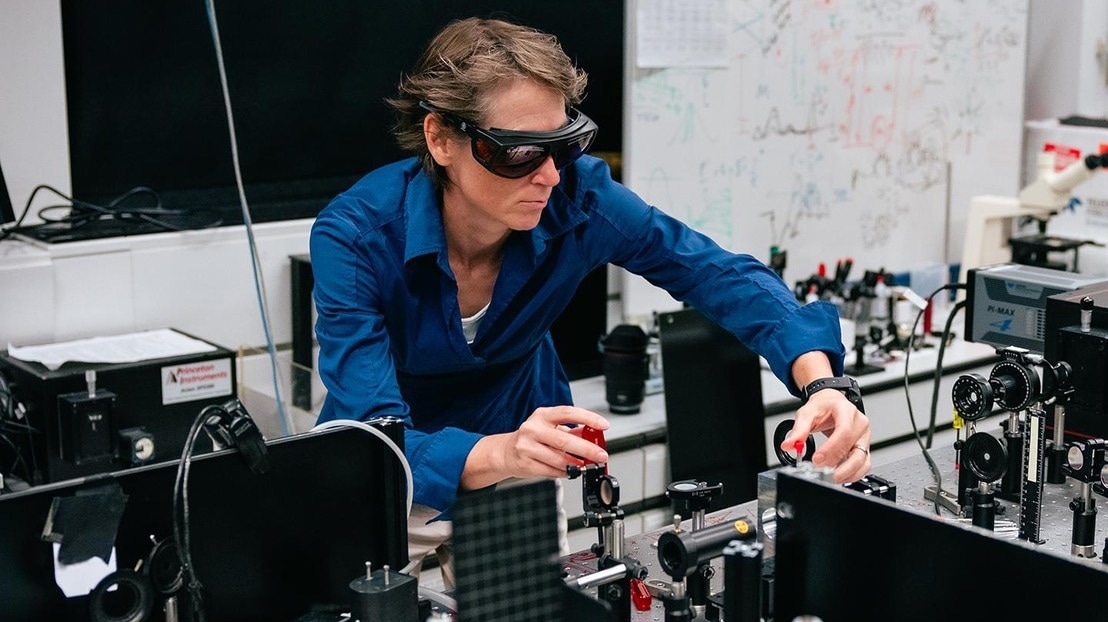EPFL researchers have achieved a groundbreaking observation by directly detecting molecules engaged in hydrogen bonds within liquid water. This advance allows for the measurement of both electronic and nuclear quantum effects—data that until now could only be accessed through theoretical simulations.
 Professor Sylvie Roke with the correlated vibrational spectroscopy (CVS) setup in EPFL's Laboratory for Fundamental BioPhotonics. Image Credit: Jamani Caillet.
Professor Sylvie Roke with the correlated vibrational spectroscopy (CVS) setup in EPFL's Laboratory for Fundamental BioPhotonics. Image Credit: Jamani Caillet.
Water is essential to life, yet the complex and dynamic interactions that link H2O molecules through hydrogen bonds remain a scientific mystery.
These bonds arise from interactions between hydrogen and oxygen atoms across water molecules, leading to an electronic charge-sharing process. This unique charge distribution forms the three-dimensional hydrogen-bond network responsible for water's distinct properties. Despite their importance, these quantum-level interactions have largely been accessible only through theoretical simulations—until now.
A team led by Sylvie Roke, head of the Laboratory for Fundamental BioPhotonics at EPFL’s School of Engineering, has pioneered a technique called correlated vibrational spectroscopy (CVS). This innovative method allows scientists to measure the behavior of water molecules within hydrogen-bond (H-bond) networks. Critically, CVS distinguishes between molecules that are actively participating in H-bonds and those that are randomly distributed and non-bonded. Conventional methods typically capture all molecules, making it challenging to differentiate between interacting and non-interacting types.
Current spectroscopy methods measure the scattering of laser light caused by the vibrations of all molecules in a system, so you have to guess or assume that what you are seeing is due to the molecular interaction you are interested in. With CVS, the vibrational mode of each different type of molecule has its own vibrational spectrum. And because each spectrum has a unique peak corresponding to water molecules moving back and forth along the H-bonds, we can measure directly their properties, such as how much electronic charge is shared, and how H-bond strength is impacted.
Sylvie Roke, School of Engineering, Laboratory for Fundamental BioPhotonics, Swiss Federal Institute of Technology Lausanne
According to the team, the method has “transformative” potential to characterize interactions in any material.
“The ability to quantify directly H-bonding strength is a powerful method that can be used to clarify molecular-level details of any solution,” said Sylvie Roke.
Looking at Things From a New Angle
To differentiate between interacting and non-interacting water molecules, the researchers directed femtosecond (one quadrillionth of a second) laser pulses in the near-infrared spectrum at liquid water. These ultra-short light pulses generated tiny charge oscillations and atomic shifts within the water, leading to the emission of visible light.
The resulting scattering pattern from this emitted light held essential details about the spatial arrangement of the molecules, while the photon colors provided insights into atomic displacements within and between molecules.
Typical experiments place the spectrographic detector at a 90-degree angle to the incoming laser beam, but we realized that we could probe interacting molecules simply by changing the detector position, and recording spectra using certain combinations of polarized light. In this way, we can create separate spectra for non-interacting and interacting molecules.
Sylvie Roke, School of Engineering, Laboratory for Fundamental BioPhotonics, Swiss Federal Institute of Technology Lausanne
The team carried out additional experiments with CVS to separate the electronic and nuclear quantum effects within H-bond networks. For instance, they altered the water's pH by adding hydroxide ions to make it more basic or protons to make it more acidic.
Hydroxide ions and protons participate in H-bonding, so changing the pH of water changes its reactivity. With CVS, we can now quantify exactly how much extra charge hydroxide ions donate to H-bond networks (8%), and how much charge protons accept from it (4%) – precise measurements that could never have been done experimentally before.
Mischa Flór, Study First Author and PhD Student, Swiss Federal Institute of Technology Lausanne
Advanced simulations carried out by collaborators in France, Italy, and the UK helped to explain these values.
The researchers highlight that this method, further validated through theoretical calculations, is versatile and applicable to various materials. In fact, several new characterization experiments are already in progress.
Roke said, “The ability to quantify directly H-bonding strength is a powerful method that can be used to clarify molecular-level details of any solution, for example containing electrolytes, sugars, amino acids, DNA, or proteins. As CVS is not limited to water, it can also deliver a wealth of information on other liquids, systems, and processes.”
💧A new spectroscopy reveals water's quantum secrets
Video Credit: EPFL
Journal Reference:
Flór, M., et al. (2024) Dissecting the hydrogen bond network of water: Charge transfer and nuclear quantum effects. Science. doi.org/10.1126/science.ads4369.